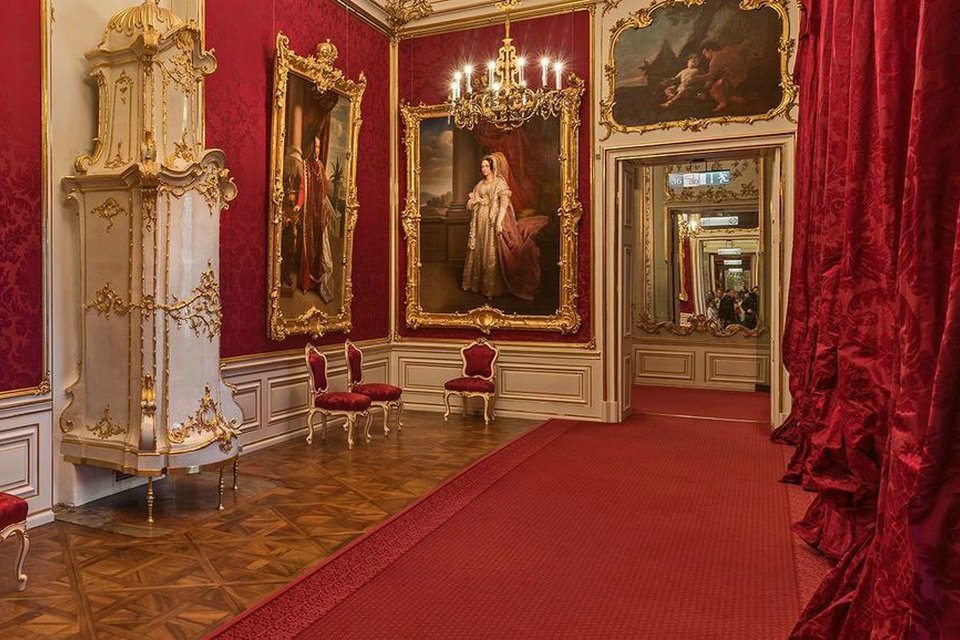Eastern rooms, Schönbrunn Palace


The interiors of the castle not only served as the residence of the imperial family, but were also built for representation purposes and were the scene of countless celebrations and ceremonies that symbolized and strengthened the prestige of the monarchy. For this purpose, many well-known artists and renowned craftsmen were appointed, who furnished the rooms with the highest elegance of the time. The styles range from the Baroque to the Rococo, the Biedermeier and styles of the Wilhelminian era, which, however, on the whole form a harmonious ensemble.
The writing room Archduchess Sophie
This room was designed for the ambitious mother of Franz Joseph. Neo-rococo furniture, typical of the epoch since 1840, is enriched with numerous family portraits and memorabilia.
Only the ladies’ secretary with elaborate mother-of-pearl inlay work has survived from this former original furnishing, demonstrating the outstanding craftsmanship of the Viennese “Hoftischler” in the 19th century. Already for Maria Theresa the room served as a library ; so there are bookshelves behind the wood paneling that you can open.
Sophie energetically and successfully pursued the plan to secure her son Franz Joseph the Habsburg throne. She was not only mother-in-law, but also aunt of Empress Elisabeth. Despite the close relationship, the ladies were very different in character and the relationship between them life difficult and conflictual.
Red salon
The red salon with its white gold wall paneling and the wall panels, which were split with red court damask, served as a cloakroom at the time of Maria Theresa. The built-in lockers were used according to inventory in 1812 as a library cabinets and stopped a hundred years later in 1914.
In the red salon are several Habsburg emperor portraits, including Leopold II, who succeeded his brother Joseph II for a short reign.
The painting to the left shows his son and successor Franz, who was the last emperor of the Holy Roman Empire since 1792 as Franz II. In 1806 he was forced by the Napoleonic Wars to dissolve the Holy Roman Empire. Two years earlier, he raised the Habsburg crown lands to the Austrian Empire. Thus, the last Roman-German Emperor Franz II became the first Austrian Emperor Franz I. He was succeeded by his son Ferdinand I, the uncle of Franz Joseph, who abdicated in the 1848 revolution in favor of his nephew.
Another daughter of Emperor Franz II./I. was Leopoldine, who was married to the Portuguese Crown Prince and later Emperor of Brazil Dom Pedro in 1817. The highly intelligent and interested in science Leopoldine initiated and supported in the wake of the independence aspirations of Brazil from the motherland of Portugal, for which the Austrian Archduchess is still revered nationwide.
Further interesting literature:
Emperor, Gloria. Dona Leopoldina. The Habsburg woman on Brazil’s throne. Vienna 2015
Schönbrunn Palace
Schönbrunn Palace (German: Schloss Schönbrunn) is a former imperial summer residence located in Vienna, Austria. The 1,441-room Baroque palace is one of the most important architectural, cultural, and historical monuments in the country. Since the mid-1950s it has been a major tourist attraction. The history of the palace and its vast gardens spans over 300 years, reflecting the changing tastes, interests, and aspirations of successive Habsburg monarchs.
In 1569, Holy Roman Emperor Maximilian II purchased a large floodplain of the Wien river beneath a hill, situated between Meidling and Hietzing, where a former owner, in 1548, had erected a mansion called Katterburg. The emperor ordered the area to be fenced and put game there such as pheasants, ducks, deer and boar, in order for it to serve as the court’s recreational hunting ground. In a small separate part of the area, “exotic” birds such as turkeys and peafowl were kept. Fishponds were also built.
The name Schönbrunn (meaning “beautiful spring”), has its roots in an artesian well from which water was consumed by the court.
During the next century, the area was used as a hunting and recreation ground. Eleonora Gonzaga, who loved hunting, spent much time there and was bequeathed the area as her widow’s residence after the death of her husband, Ferdinand II. From 1638 to 1643, she added a palace to the Katterburg mansion, while in 1642 came the first mention of the name “Schönbrunn” on an invoice. The origins of the Schönbrunn orangery seem to go back to Eleonora Gonzaga as well. The Schönbrunn Palace in its present form was built and remodelled during the 1740–50s during the reign of empress Maria Theresa who received the estate as a wedding gift. Franz I commissioned the redecoration of the palace exterior in the neoclassical style as it appears today.
Franz Joseph, the longest-reigning emperor of Austria, was born at Schönbrunn and spent a great deal of his life there. He died there, at the age of 86, on 21 November 1916. Following the downfall of the Habsburg monarchy in November 1918, the palace became the property of the newly founded Austrian Republic and was preserved as a museum.
After World War II and during the Allied Occupation of Austria (1945—55), Schönbrunn Palace was requisitioned to provide offices for both the British Delegation to the Allied Commission for Austria, and for the headquarters for the small British Military Garrison present in Vienna. With the reestablishment of the Austrian republic in 1955, the palace once again became a museum. It is still sometimes used for important events such as the meeting between U.S. president John F. Kennedy and Soviet premier Nikita Khrushchev in 1961.
Since 1992 the palace and gardens have been owned and administered by the Schloss Schönbrunn Kultur-und Betriebsges.m.b.H., a limited-liability company wholly owned by the Republic of Austria. The company conducts preservation and restoration of all palace properties without state subsidies. UNESCO catalogued Schönbrunn Palace on the World Heritage List in 1996, together with its gardens, as a remarkable Baroque ensemble and example of synthesis of the arts (Gesamtkunstwerk).